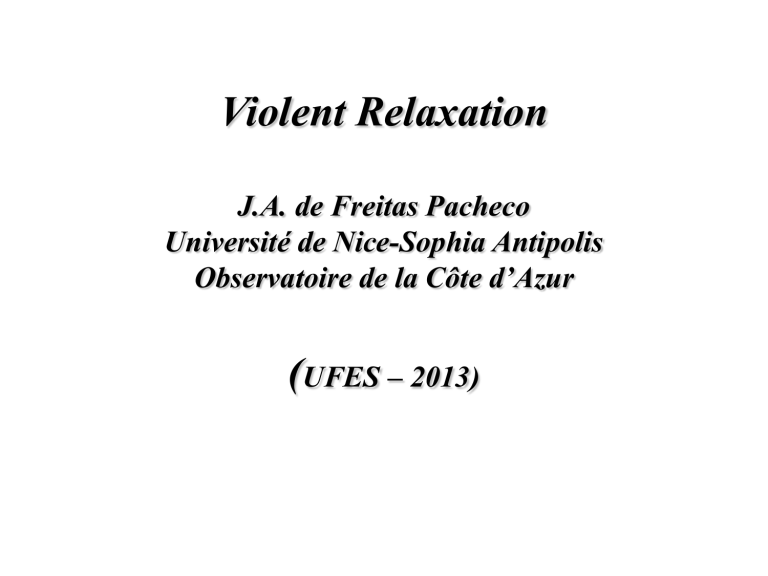Violent Relaxation - Cosmo

Violent Relaxation
J.A. de Freitas Pacheco
Université de Nice-Sophia Antipolis
Observatoire de la Côte d’Azur
(
UFES – 2013)
Relaxation of collisionless systems
•
Nearly universal brightness profile of E-galaxies requires short timescale processes and no dependence on the stellar mass, otherwise significant color gradients would be observed.
•
Simulations indicate that dark matter halos have peaked profiles (Navarro-
Frenk-White -1995) – Are these “universal” ?
•
Two-body collisions have an extremely high relaxation timescale (greater than the Hubble scale).
• Hénon (1964) – studied numerically relaxation of N-body systems in the presence of a variable potential
•
Violent relaxation (Lynden-Bell, 1967) describes how a collisionless dynamical system relaxes from a chaotic initial state to quasi equilibrium, when rapid changes in the gravitational potential occur during the gravitational collapse or following a merger episode
Color profiles of Elliptical Galaxies
Idiart, Michard & de Freitas Pacheco
(A&A 383, 30, 2002)
Relaxation & Density Profiles of Halos
•
Central slopes (dlg /dlgr) may depend on the merger history (Klypin et al. 2001) or on the initial conditions (Ascasibar et al. 2004)
•
Simulations (Henriksen 2004) indicate that dynamical young systems (clusters of galaxies) have ’’cusped’’ profiles; dwarf galaxies have ’’cored’’ ones
•
Relaxation seems to be consequence of collective effects re-excited by successive merger events (Ricotti 2003)
•
Central cusps could be the consequence of the inflow of low-entropy material
( s -log Q)
•
High resolution simulations indicate Q r , where the exponent is the same either for galaxy-size halos (Taylor & Navarro 2001) or cluster-size halos (Rasia et al. 2003), namely, 1.87
•
Hierarchical assembly of dark matter halos preserves phase-space stratification or
Q r represents a generic feature of violent relaxation (Williams et al. 2004)?
Violent Relaxation - criticisms
*
Numerical experiments indicate that N-body systems do not reach a Lynden-Bell distribution.
* Simulations of the gravitational collapse suggest that violent relaxation enhances segregation in the energy space (Funato et al. 1992).
* Simulations with N-body tree code (Merrall & Henriksen 2003)
Indicate that relaxed systems have a Gaussian distribution.
* Numerical studies of the relaxation process by Diemand et al.
(2004) Confirm that the resulting velocity distribution is Gaussian but with negative kurtosis flat topped profile.
Merrall & Hendriksen 2003
Diemand et al. 2004
Simulations
(Peirani, Durier & de Freitas Pacheco MNRAS 367, 1011, 2006)
•
Code parallel adaptive – HYDRA – (Couchman et al. 1985)
•
Cosmology
CDM ( h = 0.65 ;
m
= 0.3 ;
V
= 0.7 ;
8
= 0.9)
•
Volume
cube side = 30h -1 Mpc
•
Follow-up
60
z = 0
•
Mass resolution = 2.05 x 10 8 M
Halo identification technique
Global Evolution of Q= /
3 density calculated by Voronoi tessellation inside r
*
= 0.1GM
2 / |W|
Q -2.1
for both CDM and WDM
Halos evolved only by accretion have slightly higher Q values for a given velocity dispersion
halos evolve as M
8 / 3
nearly in virial equilibrium
Q
R
M
/
2
2 / 3
3
MR
3
3
7 / 3
2.3
Core & phase-space densities
Object
Q0047-28
CFRS03-10
MG1549
NGC 6503
NGC 3198
Coma
A1795
A133 redshift
0.48
0.94
0.11
0.000083
0.00221
0.0231
0.0625
0.0566
z
(km/s)
229
256
227
25
54
1008
786
735
(M /pc 3 ) Q
(M pc -3 km -3 s -3 )
0.43
3.58x10
-8
0.30
1.78x10
-8
0.94
8.04x10
-8
0.20
0.045
1.28x10
-5
2.85x10
-7
2.96
0.0352
0.263
2.88x10
-9
7.25x10
-11
6.62x10
-10
Central Phase-Space Density
d lg Q d lg
2.65 ( observations ) d lg Q d lg
2.16 ( simulations )
* Dark matter density overestimated in central regions of dwarf and LBS galaxies ?
* Clusters have lower phase-density than dwarfs – they suffered a series of mergers able to reduce Q.
(if the phase-space density decreases in mergers because of violent relaxation – Tremaine, Hénon &
Lynden-Bell 1986)
* Flattening of the central cusp implies that clusters should be dynamically younger !
* Is the diagram Q vs an evolutionary path ?
z = 0
Phase-space density indicator Q as a function of the halo mass at z = 0. Halos which have grown mainly by mergers have slightly lower values of the phase-space density.
Best fit Q M -0.83
Q
MR
3
3
3 6
3
Q
M
2
3
2
M M
3/ 8 3
( )
Q
M
7 / 8
M
0.88
Mass evolution
Virial ratio 2E/|W|
Potential Energy
Kinetic Energy
phase-space density dispersion velocity central density
Examples of Individual Evolution
dQ/dt evolution d /dt evolution
Effects of Mergers
Simulations - main results
•
The core density of halos decreases on the average by one order of magnitude in the interval 10 < z < 0
•
A rapid increase of the velocity dispersion associated to the relaxation process
(energy transfer from bulk-to-random motions) occurs in the redshift interval
10 < z < 6.5, followed by a late period of “slow heating”
•
Merger episodes show an energy transfer from bulk-to-random motions due to collective effects, heating all particles regardless their initial energies
•
Halos issued from simulations with particles of different masses relax as predictions of “violent relaxation”, i.e., all particles have the very same velocity dispersion.
•
The phase-space density indicator Q decreases on the average by a factor of 40 in the first 0.5 Gyr and then by a factor of 20 during the late evolution.
Phase-space density at shell crossing
•
Non-linear effects are difficult to be analyzed by analytical methods
•
Press-Schechter approach – spherical symmetric overdense region of radius R(t) evolves as a closed universe
•
As long as expansion is matter dominated, the external radius R(t) enclosing a mass M obeys the equation d R
GM dt
2
R
2
R
2
R
2
2 GM
2 E
R
3
R
2
1
dR
2
2 dt
a
2
a
2
GM
8
R
E
3
G
Kc a
2
2
• Integration constant E related to the “curvature” of a “closed” world-model
Parametric solution
R
R max
2
and t
t col
2
sin
Maximum expansion at = and collapse at = 2 with t col
2 R 2 max
2 E
2 R 3 max
2 GM
Evolution
a) in the early phases, the perturbation expands as fast as the background but the contrast increases b) at maximum radius (zero kinetic energy) the perturbation “detaches” the background and begins to collapse c) in this situation, the potential energy is comparable to the kinetic energy and the system expands, contracts, relaxes until the virial relation is satisfied d) in the relaxation process, bulk motion is transferred to random motions via an important phase mixing mechanism
At maximum expansion (dR/dt = 0)
E
GM
R max
After “bounce”, since energy is conserved
E
1
2
V
2
GM
R
V
V
GM
R
V
At maximum expansion
0
max
4
3 M
3
R max
3
32 Gt
2 max
Using the background relation (Einstein-de Sitter)
b
1
6
Gt
2
Their ratio
max
b
9
2
16
5.55
R max and similarly, for the contrast after collapse
2 R
V
2 t col
2 3
R max
2 GM
8
2 3
R
V
2 GM G
3
V
1
6
b
V
b
18
2
177.6
Virialization redshift for a halo of mass M
Spherical model
The expected density contrast at virialization
V b
18
2
82
z m v
z m v
2
Mean halo density at virialization:
V
3 H
0
2 m
8
G
,0
(1
z v
)
3
V
3 M
4
R
V
3
Since 3
2 = -2E , the 1D velocity dispersion
3
2
3
1/ 3
1
3
2 / 3
3/ 2
0
2
1/ 2
H GM where
H R
3
GM
0 max
/ using the fit from simulations
M
11
185 /(1
z v
)
2.86
it results for the phase-space density
Q
3.51 10
9
1.54
M
11
3
3
3
See details in arXiv:0701292
Phase-space density at virialization
Phase-space mixing
Phase Mixing
Diffusion of nearby points in the phase-space due to differences in orbital periods
This process is, in general, reversible (the system keeps the knowledge of the initial conditions
Chaotic mixing
The system loses information about initial conditions (irreversible process).
Diffusion of nearby points in the phase-space is due the chaotic nature of the orbits
The diffusion time scale is defined by the Lyapunov exponents. For a collisionless system, the sum of all Lyapunov exponents is equal to zero
i
lim t
1 lg t i dr
L i axes of an ellipsoid (2N dimensions) in phase-space with a mean radius r
Regular orbits i
= 0 Chaotic orbits – divergence of orbits exp( t)
Phase-space evolution of particles in a harmonic potential well
(Dehnen 2005)
Mixing is due to non-local large scale dynamics, occurring far from equilibrium but promoting equilibrium
Phase-space mixing in mergers
Example of two sub-halos captured in eccentric orbits and disrupted by tidal forces.
Satellites transfer angular momentum to the main halo.
Main-halo M = 4.0x10
sub-halo-1 M = 1.6x10
11 M
1D
12 M
1D
= 202 km/s
= 51 km/s Po ~ 6 Gyr a ~ 100 kpc sub-halo-2 2.8x10
11 M
1D
= 78 km/s Po ~ 2 Gyr
After merging, the velocity distribution of structures are
“flat-topped” Gaussians
Main halo has a kurtosis
k =[<v 4 >/<v 2 > 2 ]-3 = -0.57
while subhalo-2 has k = -0.73
Subhalo-1 preserves identity and develops high velocity tails.
Subhalo2 mixes completely in a timescale of ~ 3.4 Gyr
Top – evolution of the virial ratio
(whole system).
A maximum occurs at each periastron passage.
Right – structures in phase-space appear in each periastron passage
Main halo – kurtosis = -0.64
Subhalo – k = -0.85
Halo – M =3.3x10
12 M subhalo – 5.2x10
11 M
Totally disrupted subhalo of mass 1.2x10
12 M comparable to that of the main halo 4.3x10
13 M
At z = 0 the captured halo is completely mixed in phase-space.
Mixing occurs mainly at periastron and are probably driven by compressive tidal shocks
Again, the main halo has a negative kurtosis =
-0.57 and the subhalo k = -0.65
Summary
•
The relaxation of collisionless systems is not fully understood at present time
• Possible issues – relaxation via collective effects and/or in the presence of rapid changes of the gravitational potential (“violent relaxation”)
• VR can be seen as a transfer of kinetic energy from bulk to random motions
•
VR predicts the same velocity dispersion for particles of different masses constituting the system – numerical experiments confirm such a prediction
•
Different numerical experiments indicate that systems relaxed via gravitational collapse and/or mergers have velocity distributions described by Gaussians with negative kurtosis (“flat-topped” profiles) – confirmed by cosmological simulations.
•
The phase-space density indicator Q decreases by several orders of magnitude during the relaxation process. Predictions based on the “spherical model” are in agreement with results of cosmological simulations.







